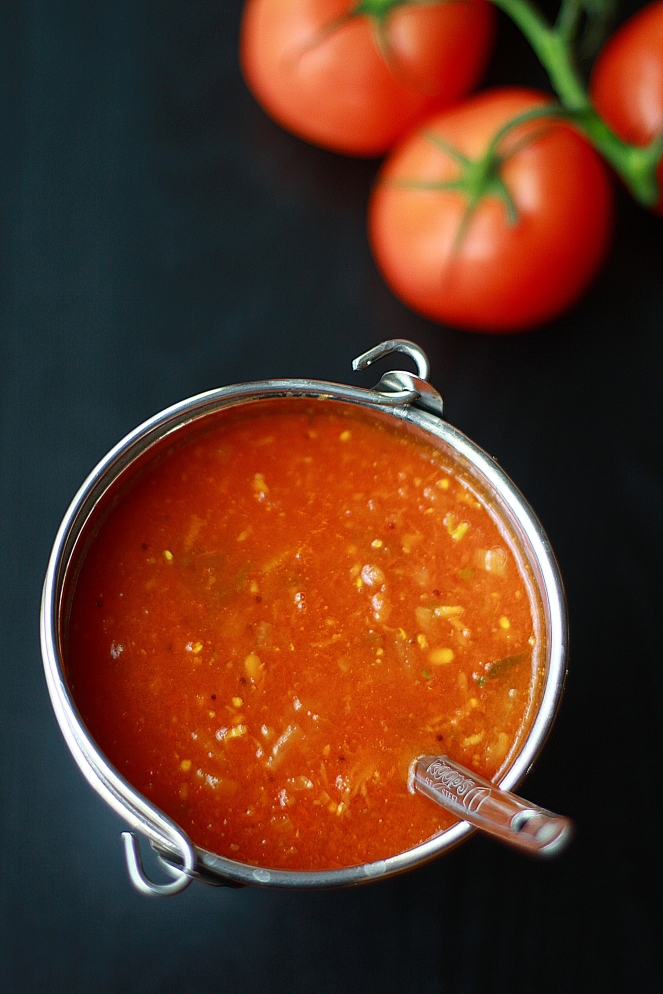Sutta Appalam Inji Kuzhambu. ( Fire roasted Appalam cooked in Ginger Tamarind Gravy).

Every morning when its time to decide the day`s menu, I promise you I really get stumped. It`s the same story everyday….I decide on Vazhakkai Podimas and then to my dismay realise that I am out of Dhania for the spice powder. Then I think why not Pavakkai Pitlae, but the pavakkai is in a very pitiful state. Dunked in to the trash can. Then again…Adai? no way I got to soak for at least 3-4 hours….Back again to the open fridge….Capsicum Pulav? Well….capsicum yes, but not enough curd or sour cream for a good serving of raita…and me cannot have pulav without raitha…Blah….how much more can one dwell on a simple culinary decision?
Today the only thing I had loads of was fresh ginger preserved in a paper towel Ginger!!! Aha…suddenly dawned on me Bharathi`s Inji Kuzhambu…The only thing that bothered me was I had to throw in some thing in the gravy. I never prefer plain sambars with no vathals or vadagams or veggies!!! I could not pair even a single veggie in the fridge with this one, so I decided to modify it to a Sutta Appalam Inji Kuzhambu redolent with its flavours and aromas. So here we go…
INGREDIENTS:
2 Appalams fire roasted and broken in to big pieces.
2 Tbsp roughly chopped Ginger.
1 Tbsp finely chopped Ginger.
Salt
Hing
Turmeric Powder.
1 1/2 cups of tamarind water extract.
Curry Leaves.
Roast in Oil Individually:
2 1/2 tsp Dhania.
1/2 Tsp Methi Seeds.
2 Tsp Toor Dhal.
7-8 Red Chillies. (Kindly alter the red chillies according to personal taste).
The 2 Tbsp of roughly chopped Ginger pieces.
Tempering:
Mustard, Curry leaves, Gingely Oil.
PREPARATION:
- As already mentioned take any appalam of your choice and slowly roast it over direct fire. If you have leftover Vadams or Vethals you can use those too. Fire roasted appalams are a personal favourite of mine. Break in to slighly bigger pieces and set aside.
- Roast in gingely oil all the specified ingredients and pop them in to a mixer. Grind to a smooth paste with water. Keep aside.
- In a kadai, add 2 spoons of gingely oil and when hot add mustard, curry leaves, ginger and saute for a few seconds.
- Add immediately the tamarind water, ground paste, salt, hing and turmeric powder.
- Now add the broken pieces of appalam also to the gravy.
- Let them all simmer on a medium low flame for about 25 minutes or so.
- You will see that the oil seperates fromt the gravy and all the raw smell is gone.
- Switch off the stove and garnish with chopped corriander.
- Serve with Sepangkizhangu Roast (Arbi Fry) and Crunchy Vazhakkai Chips.
HINT:
In my opinion, any of the varieties of tamarind based gravies, always taste better after a day or two later. By afternoon, the kuzhambu was smelling so awesome with the flavours and spices soaking up really well.
There are so many different varieties of red chillies and ginger, so re-adjust the quantity of both depending on personal preference. The end result does not reek of the ginger flavour. It`s just a mild after-thought flavour.





